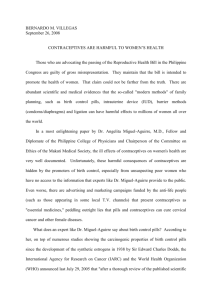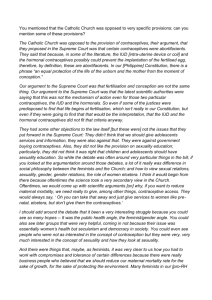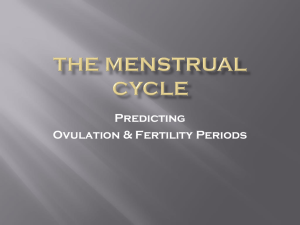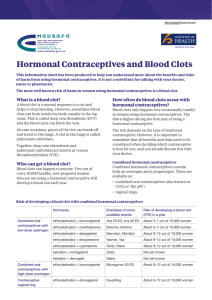History of Hormonal Contraceptives
advertisement
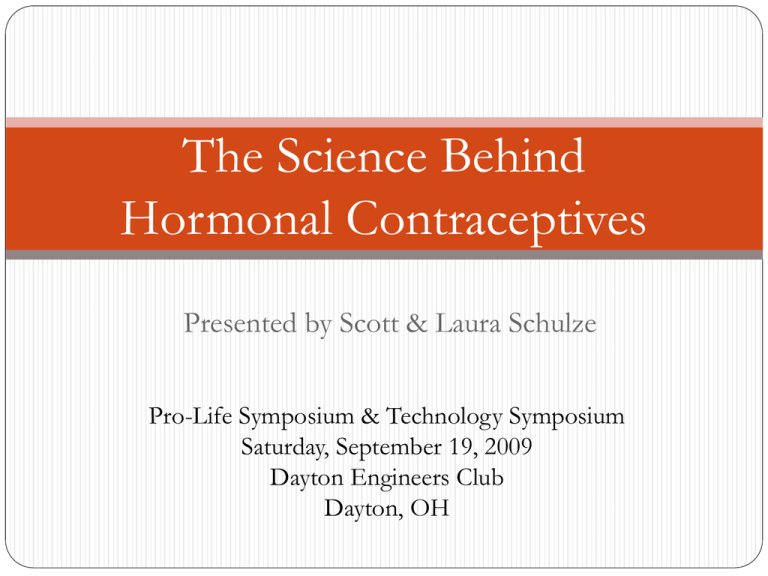
The Science Behind Hormonal Contraceptives Presented by Scott & Laura Schulze Pro-Life Symposium & Technology Symposium Saturday, September 19, 2009 Dayton Engineers Club Dayton, OH Overview How the Body Naturally Works History of Hormonal Contraceptives How Contraception Unnaturally works What does Planned Parenthood say about Hormonal Contraceptives Healthy Alternatives to Contraceptives Overview How the Body Naturally Works History of Hormonal Contraceptives How Contraception Unnaturally works Planned Parenthood & Hormonal Contraceptives Healthy Alternatives to Contraceptives The Female Reproductive System Pituitary Gland Follicle-Stimulating Hormone (FSH) Ovaries Estrogen Cervix Endometrium Pituitary Gland Luteininzing Hormone (LH) Ovulation Progesterone How the Body Naturally Works Three things necessary for Conception of baby (embryo) Sperm Egg Cervical Mucus Helps healthy sperm reach egg Implantation onto Uterine Wall is necessary for baby (embryo) to survive Overview How the Body Naturally Works History of Hormonal Contraceptives How Contraception Unnaturally works What does Planned Parenthood say about Hormonal Contraceptives Healthy Alternatives to Contraceptives History of Hormonal Contraceptives 1550 BC Egyptian Papyrus mentions the use of Crocodile Dung before intercourse Ancient Arabian documents mention the use of Elephant Dung mixed with Honey Incas, Myans, Aztecs used roots of plants like mandragora Also used in ancient times were: Seeds of Queen Anne’s Lace, Wild Carrot, Pennyroyal, Artemisia, Myrrh, Rue, Pomegranate Seeds History of Hormonal Contraceptives 7th Century BC the Silphion Plant from Cyrene Silphion is a Giant Fennel plant Contraceptive & Abortifacient Only grew in a 125 mile x 30 mile stretch of Libya Over harvesting led to increase in value “worth its weight in silver” Extinct by 2nd Centruy AD Asafoetida (used in Worcestershire Sauce) Cheaper but less expensive alternative to Silphion History of Hormonal Contraceptives Silphion Plant from Cyrene on an ancient coin. The plant created a huge economic boost for Cyrene The usage of the Silphion is implied History of Hormonal Contraceptives 1873 Congress passes Comstock Law – birth control illegal 1914 Eugenics advocate Margaret Sanger coins term “birth control” in her journal The Woman Rebel, flees country to avoid lawsuits 1918 The Crane Decision allows birth control for therapeutic purposes 1921 Margaret Sanger forms American Birth Control League (Planned Parenthood Federation of America) History of Hormonal Contraceptives 1921 Haberlandt showed that transplantation of ovaries of pregnant rabbits into fertile female rabbits suppressed their ovulation and fertility 1944 The effective hormone was found to be progesterone 1936 Margaret Sanger orchestrates court battle which results in legitimizing birth control and official recognition by AMA 1938 Inhoffen & Hohlweg synthesized Ethinyl-Oestradiol History of Hormonal Contraceptives 1941 Russel Marker makes Synthetic Progesterone with Mexican wild yams (cabeza de negro) 1951 Margaret Sanger has 200 birth control clinics 1951 Margaret Sanger asks Dr Greg Pincus to create a contraceptive pill 1951/1954 Carl Djerassi creates pill form of synthetic progesterone 1952 Frank Colton develops a pill form of synthetic progesterone 1953 Margaret Sanger secures funding for Dr Pincus to continue development of a contraceptive pill History of Hormonal Contraceptives 1954 Dr Pincus & Dr John Rock begin first human trials of their pill (high dose) in Boston under guise of a “fertility study” due to anti-birth control laws in US The study uses 21 days of pill + 7 days off to allow for menstruation so the pill will seem “natural” 1955 Conclusive results of study announced 1956 Clinical testing of Enovid begin in San Juan, Peurto Rico due to anti-birth control laws in US. Pills made by G.D. Searle 3 Women died + 17% had side effects but no action taken History of Hormonal Contraceptives 1957 Enovid submitted to FDA for menstrual disorders (GD Searle) 1959 Dwight Eisenhower – Birth Control is “not our (govt.) business” 1960 Enovid submitted to FDA as a contraceptive (what is was actually developed for) • First drug in history to be given to a healthy person for long-term use • 1960 Enovid approved by FDA as a contraceptive History of Hormonal Contraceptives 1961 Anovlar – First European oral contraceptive introduced 1962 G.D. Searle (Enovid) receives reports of dangerous side effects 11 Deaths, Blood Clots, Heart Attacks – no action taken Complaints dismisses as “exaggerated” Considered the “price women had to pay” for a contraceptive 1962 Ortho Novum hits US market. Other pills follow 1964 Lyndon B. Johnson pushes legislation for federal support of birth control for the poor History of Hormonal Contraceptives 1965 Griswold v. Connecticut – US Supreme Court rules prohibition of birth control sales is violation of “right to privacy” 1967 NAACP accuses Planned Parenthood of racial genocide 1969 A Doctor’s Case Against the Pill (Barbara Seaman) published 1970 After Congressional hearings, information on side effects of the pill are included in the packaging 1972 Eisenstadt v. Baird – US Supreme Court rules against the prohibition of birth control sales to single women 1974 Govt. supports Birth Control clinics in 2,379 counties (77%) 1980’s Low dose birth control pills introduced. Original high dose pills removed from market History of Hormonal Contraceptives 1990 FDA approved Norplant 2002 Norplant removed from US market 2002 FDA approved Norplant-2 1999 FDA approved Plan B (Emergency Contraception) 2000 FDA approved RU-486 (Abortion Pill) 2000 FDA approved Mirena 2001 FDA approved Nuva-Ring 2001 FDA approved Ortho Evra Patch 2004 FDA approved Depo-Provera 2007 FDA approved Lybrel Overview How the Body Naturally Works History of Hormonal Contraceptives How Contraception Unnaturally works What does Planned Parenthood say about Hormonal Contraceptives Healthy Alternatives to Contraceptives Birth Control Pills Three Kinds: • “Mini-pill” – progestin only • Combination – progesterone and estrogen • Seasonale – longer cycling Used by 10 million women in the United States, 4 million are 25 years old and younger. 4- Pronged Attack on a Woman’s Fertility 4) Lowers efficiency with which the fallopian tubes propel eggs from ovaries to uterus. 3) Changes the lining of the uterus so that the tiny baby boy or girl cannot implant and grow. CHEMICAL ABORTION 1) Prevents ovulation from occurring. (Prevents release of egg from ovary.) 2) Dries up mucus so that sperm can neither live in vaginal environment nor enter the cervix. Common Side Effects of Birth Control Pills • Nausea and vomiting (in about 10% of users) • Symptoms of PMS: fatigue, breast tenderness, irritability, difficulty concentrating, headaches/migraines, bloating/weight gain/water retention • Mood swings, depression • Weight loss • Loss of sex drive • Mid-cycle bleeding • Dysmenorrhea (painful menstruation) • Amenorrhea (absence of menstruation) • Vaginitis and vaginal infections • Temporary or permanent infertility when discontinuing Pill Risks Associated with Birth Control Pills • Blood clots – MI, Stroke, Pulmonary Embolism, Renal Artery Thrombosis & Kidney Damage, Temporary/Permanent Blindness • OCP use and obesity: DVT risk increased 10 fold • Hispanic women with hx of GDM – thrombosis risk • WHO Study: Migraines associated with increased risk of cerebral thromboembolism • Smokers over age of 35 – heart disease, MI, stroke • Mild elevation of blood pressure (hypertension) • Cancer of the Breasts and Cervix NIH: Estrogen is a known human carcinogen. 2002 Contraindication of Birth Control Pills Cannot be used by those with a history of: • Breast cancer • Blood clots or risk to develop blood clots • Liver disease • Kidney disease • Unexplained uterine bleeding • Smokers over age 35, • Melanoma (a type of skin cancer) • Those on certain medications (e.g. antibiotics) Ortho-Evra Square patch that slowly releases a combination of estrogen and progestin hormones through the skin. • Worn for three weeks, off for one week • Same mechanism of action, side effects and risks as the pill • Can cause rash or skin irritation at site of patch • Seems to be less effective than the Pill FDA’s Approval of the Ortho Evra Patch Prior to the FDA approval of 'The Patch' in November 2001, an FDA medical reviewer took exception with the manufacturer's conclusions regarding two cases of blood clots in the lung affecting two, rather young participants in the Ortho Evra clinical trials. “(the reviewer) DOES NOT AGREE WITH THE SPONSOR'S [Ortho-McNeil] ABOVE CONCLUSIONS. The two cases of pulmonary embolus, a serious and potentially fatal condition, must be counted as two cases in the … group.” Despite the warning, the FDA gave Ortho Evra approval. July 2005, an investigation by the Associated Press exposed that 17 of the 23 deaths associated with the use of the Ortho Evra birth control patch appeared to be related to the formation of blood clots. November 2005, four months after the Associated Press report, the FDA fostered a label change to the product, indicating the increased risk of blood clots, and representing double the risk of clots for women taking The Pill. Nuva Ring Thin, transparent, flexible ring inserted into the vagina where it slowly releases estrogen and progestin hormones into the body. • Left in for three weeks, out for one week • Same mechanism of action, side effects and risks as the pill and patch • Can cause vaginal irritation and discharge Depo-Provera Most widely-used contraceptive injection in the world that lasts three months. Mechanism of Action • Prevents pregnancy by inhibiting ovulation • Abortifacient: alters normal growth of endometrium and prevents implantation of newly conceived baby • Reduced Bone Density • Amenorrhea, Headaches, Weight Gain, Low Birth Weights • Increased Risks for Breast Cancer and STD’s • Delayed return in fertility (up to 18 months) • Risk of Breast Cancer tripled if use the shot for at least 2 years before age of 25. Birth Control Implants Five or six silicone rods surgically inserted into arm, releasing hormones into the bloodstream and lasting for five years. Withdrawn from US market in 2002 Norplant A thin rod inserted under the skin of the upper arm, containing a synthetic hormone that is released into the body over three years. Same mechanism of action as Pill. Pain at insertion site, acne, increased BP, increased clots, irregular bleeding Emergency Contraception Known as “the morning-after pill,” EC is a high dosage of the birth control pill. Plan B® is used to prevent pregnancy after an unprotected sexual encounter. It works by delaying ovulation and fertilization, and perhaps preventing implantation in the uterus. It does not terminate an established pregnancy. (According to the ACOG definition of pregnancy) • Nausea and vomiting • Breast tenderness • Ectopic pregnancy • Blood clot formation Progestin-only EC RU-486 Mifepristone + Misoprotol • Referred to as “the abortion pill” but is actually a process of consuming multiple pills • Man-made steroid designed to work against a woman’s normal, natural state during pregnancy. • First visit – RU486 pills given to kill baby • Second visit – Misoprostol pills/suppositories given in attempt to expel the dead baby • Final visit – If RU486 failed, surgical abortion scheduled • Side effects: nausea, abdominal pain, vomiting, heavy and extended bleeding, heart attack, hemorrhage, impaired future fertility FDA’s Approval of RU-486 FDA’s Approval of RU-486 (developed by the Population Council) The median total review time for new drug applications is 14.8 months FDA review time for RU-486 was 6 months. FDA quickly approved RU-486 on “fast track” process reserved for drugs used for life threatening diseases RU-486 Expedited Clinical Trials 3-8% Unsuccessful Pain, Nausea, Cramps, Bleeding, Vomiting 3% Required Blood Transfusions or Surgery Several Maternal Deaths linked to RU-486 A similar abortion drug was secretly tested in Philippines & Mexico as “tetanus” vaccine Intra-Uterine Devices • A small, flexible, plastic t-shaped device that contains either copper or the hormone progesterone and is inserted into the uterus by a clinician to prevent pregnancy. • The UID can be left in place for 1 to 10 years, depending on the type of IUD. Intra-Uterine Devices How It Works: • Kills sperm before they reach the ovum, affecting cervical mucus • Inhibits implantation • IUD containing progesterone also can inhibit ovulation to some degree Intra-Uterine Devices • Increased risk of miscarriage (spontaneous abortion) • Ectopic (extrauterine) pregnancies 10 times above usual incidence • Pelvic inflammation that can cause sterility • Anemia due to excessive menstrual bleeding • Embedding, migration of fragmentation of IUD • Spotting or prolongation of menstrual flow • Increased risk of infection • Occasional perforation of uterus, cervix, or bladder requiring surgery • Backache • Copper toxicity – poisoning of the organs • Localized pain that persists each time ovulation occurs Overview How the Body Naturally Works History of Hormonal Contraceptives How Contraception Unnaturally works What does Planned Parenthood say about Hormonal Contraceptives Healthy Alternatives to Contraceptives What does Planned Parenthood have to say about Oral Contraceptives? Quotes from Margaret Sanger, Eugenics Promoter & founder of Planned Parenthood: “More children from the fit, less from the unfit – that is the chief aim of birth control” – Birth Control Review, May 1919 “The most merciful thing that a large family does to one of its infant members is to kill it” Women and the New Race, 1920 “(The purpose in promoting birth control) ‘to create a race of thoroughbreds’” Birth Control Review, November 1921 “Couples should be required to submit applications to have a child” Birth Control Review, April 1932 What does Planned Parenthood have to say about Oral Contraceptives? “(pregnancy is) an episodic, moderately extended chronic condition… may be defined as an illness…treated by evacuation of the uterine contents…” Dr. Warren Hern, “Is Pregnancy Really Normal?” Family Planning Perspective, Planned Parenthood vol 3, no 1, Jan 1971, pg1. “If your parents are stupid enough to deny you access to birth control, and you are under 18, you can get it on your own. Call Planned Parenthood” Ad in Dallas Observer, Jan 30, 1986 “No.You do not need your parents’ permission to get birth control at Planned Parenthood, and we will not tell your parents that we have seen you. At Planned Parenthood all of our services are confidential (for) teens age 12 and older. Article on Planned Parenthood website What does Planned Parenthood have to say about Oral Contraceptives? Today, we have many safe and effective birth control methods available to us PlannedParenthood.org Do Combined Oral Contraceptives delay a woman’s return to fertility? NO: International Planned Parenthood website YES: 1 to 2 month delay: PlannedParenthood.org What does Planned Parenthood have to say about Oral Contraceptives? Do IUD’s, Implants or Injectibles cause Abortions? International Planned Parenthood – NO PlannedParenthood.org – “There is no Proof this actually happens”: American College of Obstetricians & Gynecologists (ACOG.org) – “Hormonal IUD thins the lining of the uterus. This keeps a fertilized egg from attaching….Copper IUD can prevent the egg from attaching to the wall of the uterus.” What does Planned Parenthood have to say about Oral Contraceptives? A main reason people use contraception? A smaller # of children better quality of life: International Planned Parenthood More kids Happier marriage: San Francisco University study Very Happy 3.25 Pretty Happy 2.98 Not Too Happy 2.46 % Very Happy 7+ kids (74%) 1-6 kids (58%) Overview How the Body Naturally Works History of Hormonal Contraceptives How Contraception Unnaturally works What does Planned Parenthood say about Hormonal Contraceptives Healthy Alternatives to Contraceptives Healthy Alternatives to Hormonal Contraceptives Effectiveness Rates Nothing 15% Spermicide 74% Withdrawal 81% Condom 84~85% Oral Contraceptive (pill) 92~95% IUD 98~99% Sterilization 99+% NFP 99+% Abstaining 100% Comparison of Artificial Methods of Birth Control and The Ovulation Method U.S. Statistics 1992 100% 90% 80% 70% 60% Method effectiveness User effectiveness Continuation rate 50% 40% 30% 20% 10% 0% OM Pill IUD Spermi Cond Diaph Natural Family Planning Pre-ovulatory “relatively” Infertile phase Bleeding Fertile phase Dry Days Post-ovulatory Infertile phase Dry Days Ovulation Why Use NFP? Safe - 100% natural - Has no health risks - Does not involve potentially harmful birth control drugs or devices Healthy - It teaches a woman to become aware of her normal fertility pattern. - Changes in a woman’s fertility pattern can alert her to possible medical problems. Advantages of Using NFP Can be used to achieve or avoid pregnancy Effective in all reproductive circumstances: Regular or irregular cycles Breast feeding Pre-menopause Etc... Early detection and diagnosis of fertility disorders Immediately reversible No alteration of physiology No side effects Not technology dependant, no harmful devices Advantages of Using NFP Easy to Learn Easy to Use Minimal Cost Involves the Couple Morally Acceptable More satisfying marriages Divorce rates: 50% vs. 2% U.S. Studies on Method Effectiveness of the Ovulation Method Study Year Couples Cycles Preg. rate St. Cloud 1974 260 1823 0.6% Dolack 1978 329 3354 1.1% Klaus, H et al. 1979 1090 12,282 1.17% Klaus, H 1981 72 808 0% 937 10,872 0.65% Wilson, M 1997(Guatemala) 1999 Resources • American Life League – www.all.org • Billings Ovulation Method Assn – www.Boma-usa.org • Breast Cancer Prevention Institute – www.bcpinstitute.org • Couple to Couple League – www.ccli.org • International Planned Parenthood – www.ippf.org • Family of the Americas Foundation – www.familyplanning.net • National Institute of Health – www.nih.gov • One More Soul NFP Center – www.OMSoul.com • Pope Paul VI Institute – www.popepaulvi.com • Planned Parenthood – www.plannedparenthood.org • University of San Francisco – www.userwww.sfsu.edu • World Health Organization – www.who.int
